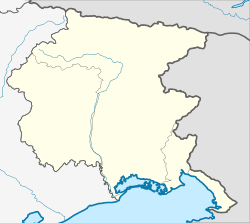Aquileia
| |
|---|---|
| Comune di Aquileia | |
 The Basilica of Aquileia. | |
| Coordinates: 45°46′11.01″N 13°22′16.29″E / 45.7697250°N 13.3711917°E | |
| Country | Italy |
| Region | Friuli-Venezia Giulia |
| Province | Udine (UD) |
| Frazioni | Beligna, Belvedere, Viola, Monastero |
| Government | |
| • Mayor | Emanuele Zorino |
| Area | |
• Total | 37.44 km2 (14.46 sq mi) |
| Elevation | 5 m (16 ft) |
| Population (30 April 2017)[2] | |
• Total | 3,302 |
| • Density | 88/km2 (230/sq mi) |
| Demonym | Aquileiesi |
| Time zone | UTC+1 (CET) |
| • Summer (DST) | UTC+2 (CEST) |
| Postal code | 33051 |
| Dialing code | 0431 |
| ISTAT code | 030004 |
| Patron saint | Sts. Hermagoras and Fortunatus |
| Saint day | July 12 |
| Website | Official website |
| Official name | Archaeological Area and the Patriarchal Basilica of Aquileia |
| Criteria | Cultural: iii, iv, vi |
| Reference | 825 |
| Inscription | 1998 (22nd Session) |
Aquileia[note 1] is an ancient Roman city in Italy, at the head of the Adriatic at the edge of the lagoons, about 10 kilometres (6 mi) from the sea, on the river Natiso (modern Natisone), the course of which has changed somewhat since Roman times. Today, the city is small (about 3,500 inhabitants), but it was large and prominent in classical antiquity as one of the world's largest cities with a population of 100,000 in the second century AD[6][7] and is one of the main archaeological sites of northern Italy. In late antiquity the city was the first city in the Italian Peninsula to be sacked by Attila the Hun.
It is currently a comune (municipality) in the Regional decentralization entity of Udine, Friuli-Venezia Giulia.
- ^ "Superficie di Comuni Province e Regioni italiane al 9 ottobre 2011". Italian National Institute of Statistics. Retrieved 16 March 2019.
- ^ "Popolazione Residente al 1° Gennaio 2018". Italian National Institute of Statistics. Retrieved 16 March 2019.
- ^ "Aquileia". Collins English Dictionary. HarperCollins. Retrieved April 6, 2019.
- ^ "Aquileia". The American Heritage Dictionary of the English Language (5th ed.). HarperCollins. Retrieved April 6, 2019.
- ^ Bilingual name of Aquileja – Oglej in: Gemeindelexikon, der im Reichsrate Vertretenen Königreiche und Länder. Herausgegeben von der K.K. Statistischen Zentralkommission. VII. Österreichisch-Illyrisches Küstenland (Triest, Görz und Gradiska, Istrien) (in German). Vienna. 1910.
{{cite book}}: CS1 maint: location missing publisher (link) - ^ The Oxford Classical Dictionary, p. 129, at Google Books
- ^ A Brief History of Venice, p. 16, at Google Books
Cite error: There are <ref group=note> tags on this page, but the references will not show without a {{reflist|group=note}} template (see the help page).




